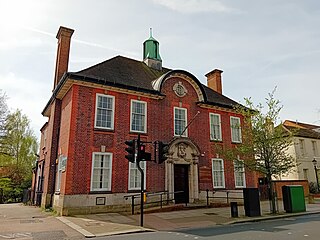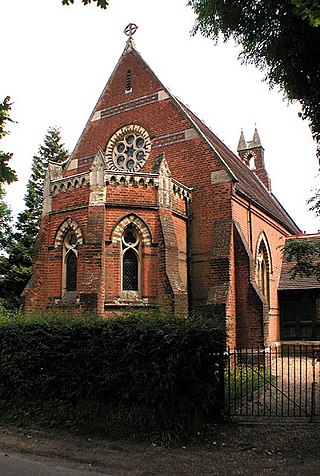
The London Borough of Barnet is a local authority area on the northern outskirts of London. The borough was formed in 1965 from parts of the ceremonial counties of Middlesex and Hertfordshire. It is the second largest London borough by population with 389,344 inhabitants as of 2021, also making it the 17th largest district in England. The borough covers an area of 86.74 square kilometres (33 sq mi), the fourth highest of the 32 London boroughs, and has a population density of 45.8 people per hectare, which ranks it 25th.

Chipping Barnet or High Barnet is a suburban market town in north London, forming part of the London Borough of Barnet, England. It is a suburban development built around a 12th-century settlement, and is located 10+1⁄2 miles (17 km) north-northwest of Charing Cross, 3 miles (4.8 km) east from Borehamwood, 5.2 miles (8.4 km) west from Enfield and 3.2 miles (5.1 km) south from Potters Bar. Its population, including its localities East Barnet, New Barnet, Hadley Wood, Monken Hadley, Cockfosters and Arkley, was 47,359 in 2011.

Osidge is a district in the London Borough of Barnet, between Brunswick Park and Southgate, just west of the border with the London Borough of Enfield. It may be loosely defined as the part of postal district N14 that is in Barnet. Osidge has no formal border and is entirely enclosed within the electoral ward of Brunswick Park, East Barnet; however Oak Hill Park forms a natural boundary to the north and Pymmes Brook to the west, with the A111 to the east and the Piccadilly line to the south and/or east.

Barnet was a local government district in south Hertfordshire from 1863 to 1965 around the town of Barnet.

East Barnet Valley was a local government district from 1874 to 1965 around the town of East Barnet. It was partly in the counties of Hertfordshire and Middlesex until 1889, when the Middlesex part was transferred to Hertfordshire. It was renamed East Barnet in 1935.

Brunswick Park is a neighbourhood, public park and electoral ward in the London Borough of Barnet. It is north of New Southgate and to the south of Oakleigh Park. Roads include Brunswick Park Road, Brunswick Avenue and Brunswick Crescent.

The A1000 is a main road in the United Kingdom, going from London to Welwyn.

John Buonarotti Papworth was a British architect, artist and a founder member of the Royal Institute of British Architects.

Barnet Gate is a hamlet on the northern edge of the London Borough of Barnet to the west of Arkley, in England. There was a settlement there during the Roman occupation of Britain and in the Anglo-Saxon period it was known as Grendeles Gatan after Grendel, the monster in the epic poem Beowulf. Manor courts were held there and brickmaking was an important local industry. It was on the edge of Southaw wood which was cleared when nearby Chipping Barnet was developed after which it was known as Barnet Gate. The Gate referred to no longer exists but was either a gate used to prevent cattle straying onto Barnet Common or a gate that marked the boundary between Hertfordshire and Middlesex.

Arkley is a village in Greater London, England, within the London Borough of Barnet. It is located 10.6 miles (17.1 km) north-northwest of Charing Cross.
Thomas Brand (senior) was an English country landowner of The Hoo, Kimpton, Hertfordshire and politician who sat in the House of Commons from 1741 to 1770.

The Mitre Inn is a public house at 58 High Street, Chipping Barnet, London. It was established by 1633 and is probably the oldest remaining of the town's once numerous coaching inns. It is a grade II listed building with Historic England and is currently styled "Ye Olde Mitre Inne".

Sigismund James Stern was a German-born merchant in the Manchester cotton trade. He was later active in banking in London and owned the Little Grove house and estate in East Barnet to the north of the city.

Bentley Heath is a hamlet in Hertfordshire, England, between Chipping Barnet and Potters Bar. It is on the north edge of the Wrotham Park estate with which it has traditionally been associated. Historically, it was in Middlesex.
William Alpheus Higgs was a London tea merchant who served as sheriff of London and Middlesex in 1887. He was a liveryman of several of the city's guilds and at the time of his death had been selected as a Radical candidate for a parliamentary constituency in north London.

Thomas Wyatt was an East Indies merchant from Willenhall in the English Midlands. He commissioned Willenhall House from John Buonarotti Papworth in 1829 which was built on an estate that he purchased in north London and which he named Willenhall.
Sir William Henry Wyatt (1823-1898) was Magistrate and Deputy Lieutenant for Middlesex, and social reformer in his role of Chairman of both the Middlesex County Lunatic Asylum at Colney Hatch and the Metropolitan Asylum for Chronic Imbeciles at Leavesden, Hertfordshire.

Greenhill was a house and estate on the site of the former Pricklers estate to the south of Chipping Barnet, on the borders of Hertfordshire and Middlesex, in what is now north London.
Andrew Reid (1751–1841) was a Scottish brewer and distiller. He was High Sheriff of Hertfordshire in 1815.





















